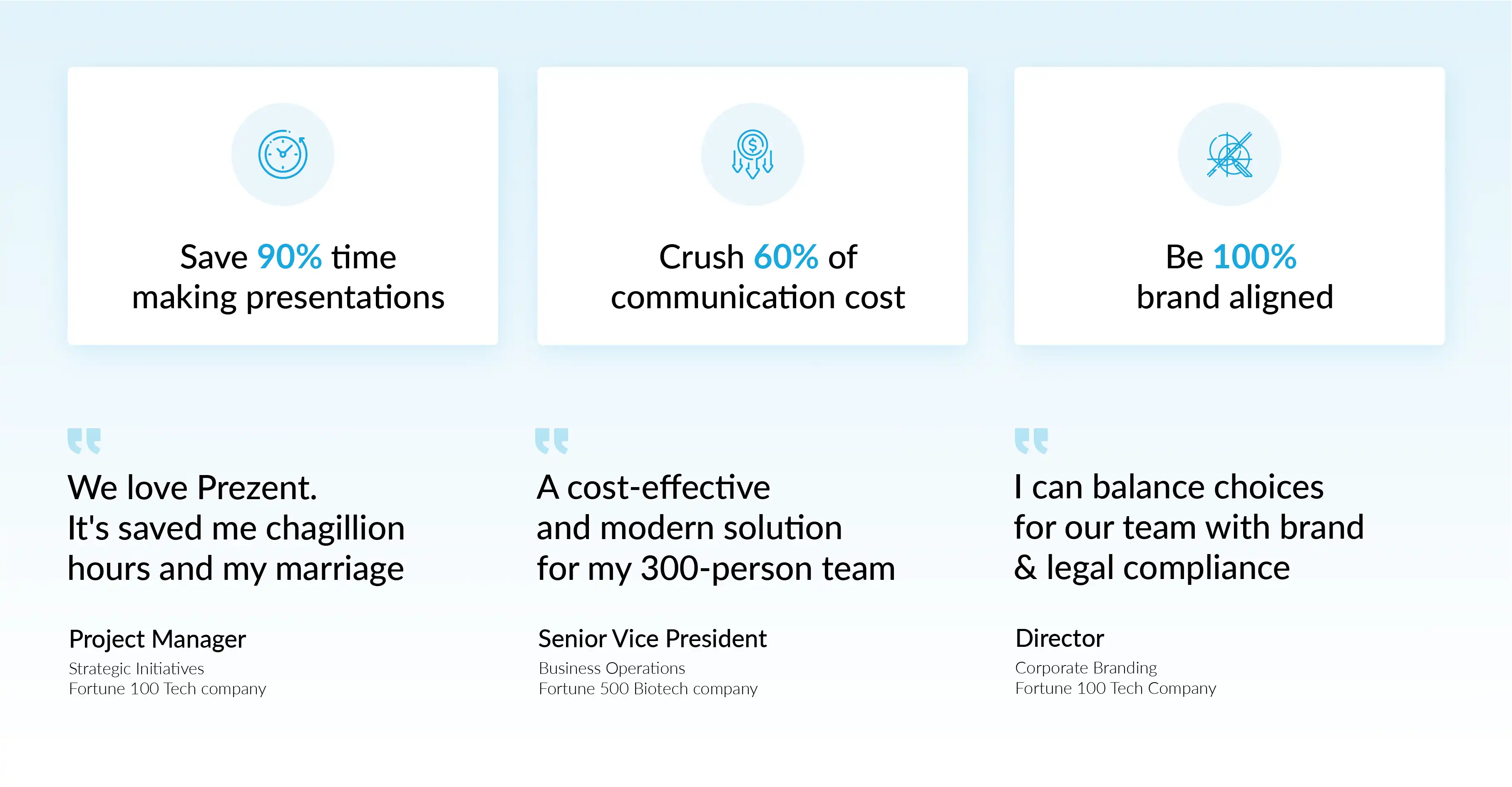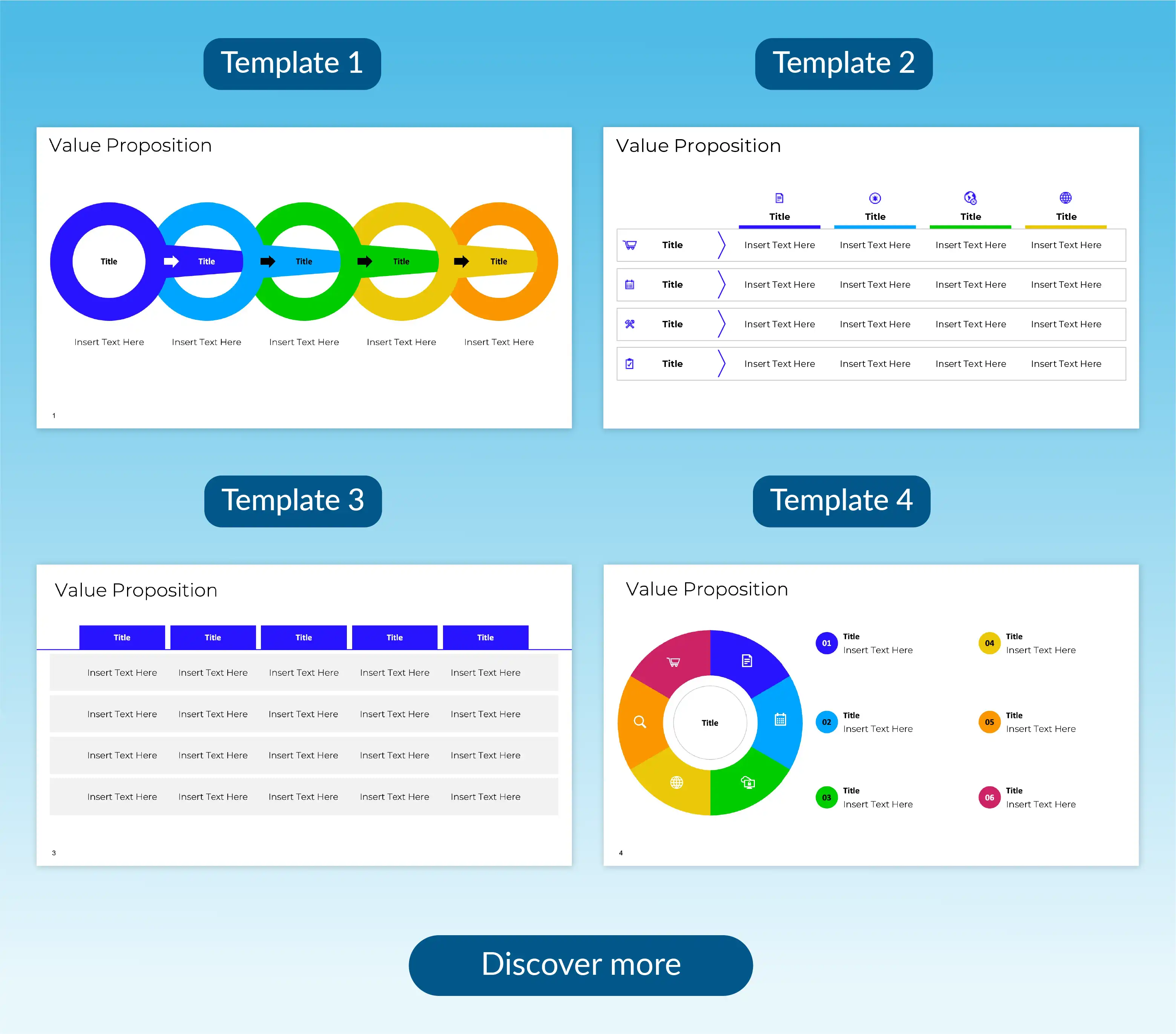How to present a value proposition: A guide with templates

In a business landscape crowded with innovations and constant competition, the ability to effectively present your value proposition can distinguish your product or service as the preferred choice. A value proposition is not just a fancy catchphrase—it's the foundational statement that encapsulates the unique value your product or service offers. It answers the quintessential question: “Why should a customer buy from you?”
This guide will provide an in-depth exploration of how to craft and present a compelling value proposition. From understanding what makes a good value proposition to the actual presentation techniques that will engage and convince your stakeholders, we'll cover all the bases.
Understanding value proposition
A value proposition is more than just a statement; it's the promise of value to be delivered, communicated, and acknowledged. It is the primary reason a prospect should buy from you. Think of it as a handshake—a way of introducing yourself and saying, "Hey, this is what I offer, and this is why it's perfect for you." At its core, a great value proposition answers the question: "Why should I choose this product or service over all the others available?" When crafted well, it becomes the foundation of your marketing efforts, guiding all your communications and making your brand unforgettable.
Key components of value proposition
To write a value proposition that creates an impact, you need to focus on three key components:
Creating clarity and relevance
A strong value proposition clearly states what your product does, who it is for, and why it is uniquely better than the alternatives. Use simple language that avoids jargon and focuses on real benefits rather than features. For example, instead of saying, "Our product uses state-of-the-art technology," say, "Our product cuts your processing time in half, allowing you to focus on growth."
Quantified value
What specific benefits can your customer expect? These could range from saving time to reducing costs. Quantifying this value helps make it tangible and believable.
For example, Prezent Premium, with its AI solutions, can help you save 90% of the time spent creating presentations manually! Quantifying the time spent makes the value proposition clearer and more believable.

Differentiating your offer
Identify and highlight the aspects of your product that set it apart from competitors. This could be anything from cost, quality, innovation, customer service, or a unique feature that only your product offers. This differentiation should be easily understandable and compelling enough to make potential customers prefer your product over others.
These components form the backbone of your value proposition, making it clear, concise, and compelling. Think of them as the core ingredients in a recipe for success.
The role of value proposition in business success
A strong value proposition distinguishes thriving businesses from those that struggle to attract and retain customers. It anchors all marketing efforts, guiding your messaging across different channels. Without it, potential customers might be unclear about why they should choose your product, leading to missed opportunities. Conversely, a well-defined value proposition ensures your brand not only meets immediate customer needs but also resonates more deeply, making it memorable and encouraging customer loyalty. This not only attracts new buyers but also turns them into lifelong advocates, which is crucial for long-term success.
Creating a unique value proposition
Identifying your target audience
To develop a successful value proposition, you must thoroughly understand your target customer. This involves more than gathering demographic information; it requires deep insights into their behaviors, preferences, and specific challenges. This detailed understanding helps tailor your value proposition to address the unique needs and desires of your customers, making it significantly more compelling.
Understanding customer needs and pain points
What are the major challenges that your customers face? Identifying these issues is crucial for refining your value proposition. Engage in activities like customer interviews and data analysis to pinpoint exactly what makes your customers' lives difficult and how your product or service can provide relief. For instance, if your product is a project management tool and you discover that customers struggle with team coordination and time management, your value proposition might read, "Enhance team productivity and streamline workflows with our easy-to-use project management solution."
Highlighting unique selling points (USPs)
Your unique selling points (USPs) are what differentiates your product from the competition. These features, benefits, or unique experiences provide your business with a competitive advantage and should be prominently featured in your value proposition. For example, if your software offers an unparalleled user experience that minimizes setup time, your value proposition could be, "Get started in minutes and save hours with our user-friendly software."
Creating a clear and concise statement
Your value proposition should be both clear and concise, communicating the essence of your offer in a straightforward and impactful manner. It's essential to craft this statement in simple language that directly addresses how your product or service makes the customer’s life better. For example, a compelling value proposition might be, "Our app simplifies your day-to-day tasks, freeing up time for what really matters." This simple sentence effectively communicates the core benefits of your offering, ensuring it resonates with the intended audience.
Tips to present a unique value proposition
Presenting your value proposition effectively is crucial for connecting with your audience and conveying the unique benefits of your product or service. Here are twelve refined strategies, each illustrated with real-life examples, to ensure your value proposition engages and converts.
Start with a Strong Hook
Starting your presentation with an impactful hook is crucial for grabbing your audience's attention right off the bat. This could be a surprising fact, a provocative question, or a bold statement that relates directly to the core benefits your product delivers. The aim is to captivate your audience from the first moment, making them eager to hear more about how your product can solve their problems or improve their lives.
Example 🚀 : Tesla provides a compelling example of using a strong hook effectively. During the unveiling of the Tesla Model 3, Elon Musk led with the bold claim, "You will not be able to buy a better car for $35,000, even with no options." This statement grabbed immediate attention and set up the audience for an introduction to a product that promised exceptional value. It framed the Model 3 as not just another car but as the best in its class, instantly creating high expectations and excitement.
Read to know more: 8 Ways for a captivating presentation start
Use Simple, Relatable Language
Clear and simple language is key to ensuring your value proposition resonates with a broad audience. Avoid industry jargon and technical terms that might confuse or alienate those unfamiliar with your specific field. Instead, opt for straightforward, everyday language that directly addresses the user’s needs and clearly highlights the benefits. This approach helps ensure that your message is not only understood but also appreciated by everyone, regardless of their technical background or industry knowledge.
Example 🚀 : Apple excels in using simple, relatable language to describe its cutting-edge technology. For instance, when introducing the Face ID technology, Apple didn't delve into the intricate technical details of the biometric technology. Instead, they simply explained, "Face ID reinvents the way we unlock, log in, and pay, using just a glance." This clear and relatable explanation quickly helped consumers understand the practical uses and benefits of the feature, making it widely accepted and appreciated.
Tell a Compelling Story
A compelling story can transform your value proposition from a simple statement into an engaging narrative that resonates with your target customer. This narrative approach helps position your product or service in the context of real-life situations, making it easier for customers to see the practical benefits and visualize how it could fit into their lives. Crafting a story around your value proposition helps illustrate its impact and makes your message memorable.
Example 🚀 : Warby Parker's story of why the company was founded—offering affordable, stylish eyewear and providing a pair to someone in need for every pair sold—effectively captures the hearts of consumers. This story not only communicates their business strategy and competitive advantage but also aligns with the values of their customers, fostering a strong emotional connection.
Read to know more: The Art of Storytelling in presentations
Highlight Key Benefits, Not Features
When presenting your value proposition, focus on the key benefits that directly address what customers want, rather than just listing the features of your product or service. Benefits should clearly articulate how they solve problems or improve the customer’s situation, effectively demonstrating the real value of your offering. This approach shifts the conversation from technical specifics to user-centric advantages, enhancing the effectiveness of your value proposition.
Example 🚀 : Instead of just highlighting its durable battery life (a feature), a popular smartphone brand advertises how its users can enjoy a weekend full of activities without needing to recharge. This directly addresses a common pain point among users—battery life anxiety—and positions the product as a perfect fit for active, on-the-go lifestyles.
Use Visuals
"Good design is good business.” Thomas J. Watson, Jr., former IBM president
Incorporating good visuals can significantly enhance the clarity and impact of your value proposition. Charts, graphs, images, and videos can help illustrate complex information, making it easier for audiences to understand and remember. Visuals can also demonstrate the effectiveness of your product or service, providing a compelling argument for its use.
Example 🚀 : Dropbox’s explanatory video simplifies cloud technology into everyday language and visuals, effectively communicating how users can benefit from their services.
Address Objections
Proactively addressing objections within your value proposition presentation strengthens your argument and reduces skepticism. By anticipating potential concerns, such as cost or usability, and addressing them with clear information, you effectively communicate the value within your product or service. This strategy not only builds trust but also solidifies your value proposition as both thoughtful and customer-centric.
Example 🚀 : Tesla’s value proposition brilliantly incorporates addressing common concerns about electric vehicles, such as battery life and charging station availability. By showcasing their robust Supercharger network and the long-range capabilities of their cars, Tesla reassures potential buyers and turns a common objection into a strong selling point.
Include Testimonials
Testimonials are powerful tools that add credibility and real-world validation to your value proposition. By sharing stories and positive feedback from those who have benefited from your product or service, you effectively demonstrate the value for customers, making your value proposition more relatable and trustworthy.
Example 🚀 : Dropbox often shares customer stories to highlight how their service isn’t just about storage but about bringing teams together and enabling collaborative work. Such testimonials not only reflect the effective value proposition of Dropbox but also help potential customers visualize how they might use the product in their own workflows.
Emphasize the Unique Selling Proposition (USP)
Your Unique Selling Proposition (USP) is what differentiates your product from the competition. A clear value proposition articulates this uniqueness and positions your brand as the preferred choice. It’s crucial to identify and communicate the distinct benefits that make your offering special.
Example 🚀 : Slack’s USP lies in how it reduces the need for internal emails and streamlines communications, a value proposition that they communicate clearly in their marketing. By focusing on this benefit, Slack has successfully differentiated itself in a crowded market of communication tools.
Demonstrate Scalability and Flexibility
Demonstrating the scalability and flexibility of your product ensures prospects that your solution can grow and adapt with their evolving needs. This is particularly crucial for B2B solutions where long-term viability is a key concern.
Example 🚀 : HubSpot showcases its scalability by highlighting how its CRM platform serves everyone from small startups to large enterprises, thus reinforcing its value proposition as a versatile and comprehensive business solution.
Engage with Interactive Elements
Interactive elements like demos, polls, and Q&A sessions make your presentations more engaging and memorable. They provide a hands-on experience of your product’s benefits, allowing the audience to see its value firsthand.
Example 🚀 : A SaaS company might use interactive demos in their webinars to show how easily their software integrates with existing tools, allowing potential customers to interact with the features directly and see the immediate benefits.
Use Data and Statistics Effectively
Supporting your claims with data and statistics can significantly enhance the credibility of your value proposition. Effective use of quantitative evidence demonstrates the success and efficiency of your product, making your proposition more compelling.
Example 🚀 : Fitbit uses statistical data to show how using their fitness trackers has helped users improve their health by quantifying activity levels, sleep quality, and other health metrics.
End with a Strong Call-to-Action (CTA)
A strong Call-to-Action (CTA) is essential to guide your audience on what to do next. Whether it’s encouraging them to sign up for a trial, schedule a demo, or simply learn more, a clear CTA is critical in converting interest into action.
Example 🚀 : At the end of a presentation on a new project management tool, the speaker might encourage the audience to sign up for a free trial by highlighting the immediate benefits of getting started now, such as a free onboarding session or a discount for early sign-ups.
How do we create a value proposition presentation with Prezent?
Creating a value proposition presentation with Prezent involves leveraging several features designed to streamline and enhance the presentation creation process. Here’s how you can effectively utilize Prezent to craft a compelling value proposition presentation:
Auto-Generator
Begin by using the Auto-Generator feature, which simplifies the initial stages of creating your value proposition. This feature helps you to draft a succinct value proposition that communicates the unique benefits of your product and service, aligning with your brand’s voice and saving time on manual layout efforts.
Story Builder
Utilize the Story Builder to craft a strong value proposition. This feature offers access to a variety of templates and storylines, such as those for a value proposition canvas, which help you articulate how your business offers unique solutions. Story Builder ensures that your narrative is engaging and strategically structured to highlight the powerful value proposition of your offering.
Slide Library
Explore the Slide Library to find professionally designed slides that suit your presentation’s theme. This feature supports the effective communication of your company's value proposition, allowing you to demonstrate value proposition examples through visually appealing slides that are consistent with your brand identity.

Best Practice Examples
For further inspiration or to benchmark against the best in the industry, use the Best Practice Library. This resource provides numerous value proposition examples from which you can learn how to develop a value proposition that stands out in the marketplace.
Template Converter and Redesign
If you have existing content, the Template Converter and Redesign tools can be used to align it with new design standards. These features allow you to refine your value proposition, ensuring that every slide reflects a perfect value proposition through professional aesthetics and compliance with brand guidelines.
Courses and Learning Modules
To ensure your skills remain sharp and your presentations impactful, engage with courses and learning modules offered by Prezent. These resources are invaluable for developing a value proposition that not only communicates benefits but also compels your audience to act.
To experience firsthand how Prezent can transform your approach to creating value proposition presentations, we invite you to sign up for a free trial today. During this demo, you'll have the opportunity to work directly with our experts who will guide you through the features and tools that Prezent.ai offers. This personalized session will help you understand how to leverage our platform to craft presentations that are not only visually compelling but also strategically aligned with your business goals. Whether you're refining an existing presentation or starting from scratch, our expert-guided demo will provide you with the insights and tools you need to communicate your unique value effectively. Sign up for a free demo and start transforming your business communications today!
FAQ's
1. What is a value proposition, and why is it important?
A value proposition is a short statement that communicates the unique benefits of your product or service, helping you differentiate from competitors. It’s crucial for positioning your business in the market.
2. How do I create a value proposition that resonates with my target audience?
To create a good value proposition, start by understanding the language your customers use and the specific needs your solution addresses. Craft a value proposition that aligns with these insights.
3. What tools can I use to write and test my value proposition?
Using the Value Proposition Canvas is a visual tool that helps brainstorm the perfect value proposition. It’s also essential to test your value proposition to determine which messages resonate most with your audience.
4. How does a value proposition differ from a mission statement?
A mission statement outlines your company’s purpose, while a value proposition is a short, focused statement of the benefits your product offers. Both are essential, but the value proposition directly communicates why customers should choose your product.
5. Can you provide examples of value propositions that stand out?
Examples of value propositions that stand out often clearly communicate their unique value, using simple, relatable language. Harvard Business School often cites well-crafted value propositions in their case studies as key drivers of business success.



.avif)







